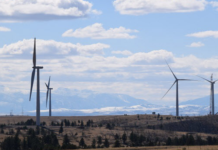The Idaho Public Utilities Commission has approved an Idaho Power Co. power purchase agreement with a 44-turbine wind project near American Falls in eastern Idaho.
The 80 MW Rockland Wind Project is a Public Utility Regulatory Policies Act (PURPA) project with a scheduled operation date of Dec. 31, 2011.
PURPA requires electric utilities to offer to buy power produced by qualified small-power producers.
The proposed agreement has many unique characteristics because of its size. All Idaho Power PURPA wind projects to date are 10 MW or smaller, which is the largest a project can be for developers to be paid an avoided cost rate that is determined and published by the commission. The avoided cost rate is to be equal to the cost the electric utility avoids if it would have had to generate the power itself or purchase it from another source.
However, projects larger than 10 MW can still qualify as PURPA projects if the developer and the utility are able to negotiate a cost that closely matches the utility's avoided cost. Because customers ultimately pay for the power generated by PURPA projects, it is not in the public's interest for the commission to approve sales agreements that result in customers paying more for electricity that could have been generated or purchased elsewhere at a lower cost, according to the Idaho Public Utilities Commission.
The negotiated levelized energy price in the 25-year agreement is $71.29/MWh, lower than the published avoided cost rate of $75.88/MWh for projects 10 MW or smaller.
Blue Ribbon Energy LLC, which develops PURPA projects smaller than 10 MW, did not oppose the agreement, but noted that Rockland was able to accept a lower payment because of tax credits and benefits it received.
Some issues resolved include not only price, but items such as delay and security provisions, mechanical guarantees and the treatment of renewable energy credits (RECs) created by the project.
The agreement contains financial damage and security provisions for the benefit of customers in the event of the project's default or failure to meet its completion date as well as mechanical availability guarantees. The developer will retain the RECs for the first 10 years, which will help offset the development cost. Idaho Power will retain the renewable energy credits for the final 15 years, when the utility may have to comply with federal renewable electricity standards or state renewable portfolio standards.
SOURCE: Idaho Public Utilities Commission



